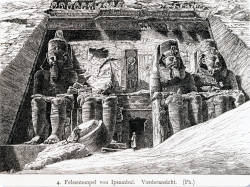Abu Simbel
Useful Information
| Location: |
Abu Simbel.
Abu Simbel is located 300 km from Aswan and only 20 km north of the border with Sudan. () |
| Open: |
All year daily 5-18. Abu Simbel by Night: All year daily 19. [2021] |
| Fee: |
Adults EGP 255, Students EGP 133. Photo permit EGP 300, Tripod permit EGP 20. Abu Simbel by Night EGP 150. [2021] |
| Classification: |
 Cave Church Cave Church
|
| Light: |
 Incandescent Electric Light System Incandescent Electric Light System
 Son et Lumière Son et Lumière
|
| Dimension: | |
| Guided tours: |
self guided. Abu Simbel by Night: D=45 min. |
| Photography: | only with permit (fee) |
| Accessibility: | no |
| Bibliography: | |
| Address: | |
| As far as we know this information was accurate when it was published (see years in brackets), but may have changed since then. Please check rates and details directly with the companies in question if you need more recent info. |
|
History
| 1264-1244 BC | temple constructed by Ramses II. |
| 1873 | rediscovered by Jean-Louis Burckhard. |
| 1979 | inscribed on the UNESCO World Heritage List. |
Description

Abu Simbel is probably the most famous egyptian temple in the world. And although it is of great beauty and really impressive, the true reason is the construction of the Nasser dam, a huge project during the science centric mid 20th century. Funds of development assistance by so-called western countries was used to build dams, actually by western companies, to create industry for western markets. This dam was constructed to produce electricity for an aluminium smelter, which was built nearby. Among numerous negative consequences was the destruction of Abu Simble, or better its flooding by Lake Nasser.
Some say, how good for the temple, out of reach of modern tourists. But at this time it was regarded a great threat to the artwork. And so there were initiatives, funds were raised, and the complete temple (or at least its front facade) was relocated, the temple became world famous. Obviously a great technical masterpiece, but as a result the new temple is a sort of fake.
The temple has an impressive and world famous facade, four huge sculptures of a sitting man, actually all of them are Pharaoh Ramses II, who lived around 1300 BC. He was definitely fond of having images made of himself in stone. There are many more inside, and of course some murals depicting him. The 22 m high statues were carved into a solid cliff face above a sweeping bend of the Nile. Today the statues are relocated just a little bit higher up the hill, facing into the same direction. This is important, as twice a year the rays of the rising sun shine deep into the full depth of the temple and illuminate the inner sanctum.
Ramses had his temple aligned so that this happened twice a year, on 22-FEB and 22-OCT. Both days became local festivals to celebrates this. The first day is his birthday, the second is the day of his ascension to the throne. Actually the people were reminded of this dates by the sun personally. Unfortunately the relocation was not that good, the modern-day builders made a mistake, and the lightshow is now one day later.
Just for completeness’s sake: there is a second similar temple. Much smaller, less sculptures, all of his favourite wife Nefertari who this lesser temple was dedicated to. And no lightshow.
The best way to visit Abu Simbel is by taking a day trip from the city of Aswan. As a result there is not much info for individual tourists to be found, they simply do not exist. There are two ways to reach Abu Simbel, by air with one of the direct flights which takes 45 minutes, or by car, either with a private driver or as part of a tour, which takes about 3 hours, but is cheaper. Egypt Air is the only airline that offers the direct flights between Aswan and Abu Simbel, and a shuttle bus will wait at the entrance. The visitors have 1.5 hours to see before they have to leave for the return flight.
 Subterranean World Heritage List
Subterranean World Heritage List Search DuckDuckGo for "Abu Simbel"
Search DuckDuckGo for "Abu Simbel" Google Earth Placemark
Google Earth Placemark Abu Simbel - Wikipedia
Abu Simbel - Wikipedia Index
Index Topics
Topics Hierarchical
Hierarchical Countries
Countries Maps
Maps